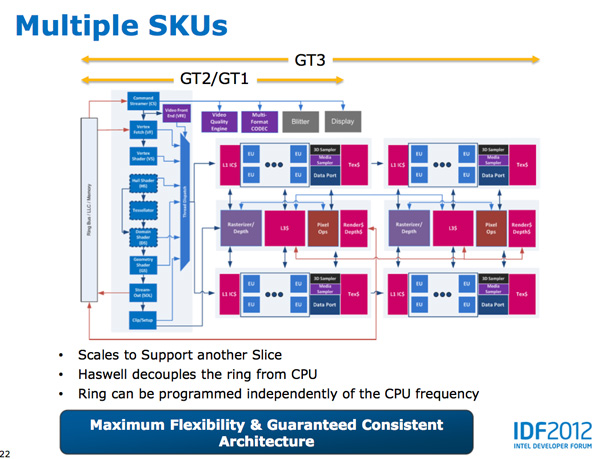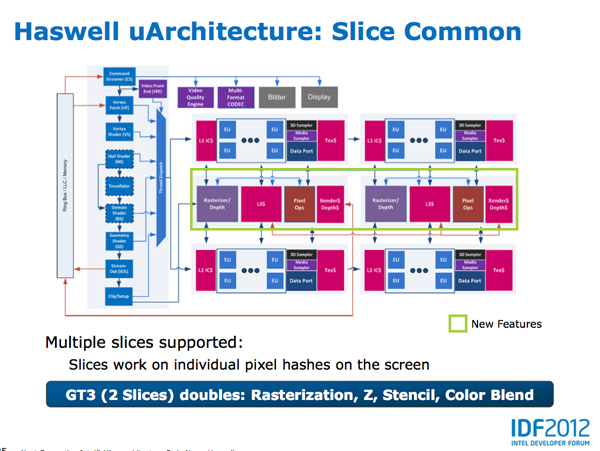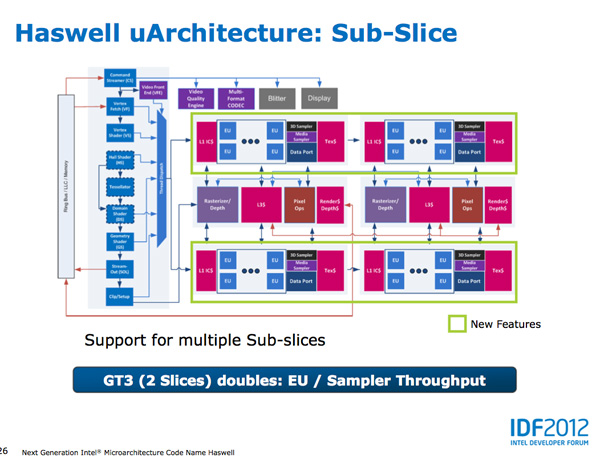Intel's Haswell Architecture Analyzed: Building a New PC and a New Intel
by Anand Lal Shimpi on October 5, 2012 2:45 AM ESTHaswell's GPU
Although Intel provided a good amount of detail on the CPU enhancements to Haswell, the graphics discussion at IDF was fairly limited. That being said, there's still some to talk about here.
Haswell builds on the same fundamental GPU architecture we saw in Ivy Bridge. We won't see a dramatic redesign/re-plumbing of the graphics hardware until Broadwell in 2014 (that one is going to be a big one).
Haswell's GPU will be available in three physical configurations: GT1, GT2 and GT3. Although Intel mentioned that the Haswell GT3 config would have twice the shader count of Haswell GT2, it was careful not to disclose the total number of EUs in any of the versions. Based on the information we have at this point, GT3 should be a 40 EU configuration while GT2 should feature 20 EUs. Intel will also be including up to one redundant EU to deal with the case where there's a defect in an EU in the array. This isn't an uncommon practice, but it does indicate just how much of the die will be dedicated to graphics in Haswell. The larger of an area the GPU covers, the greater the likelihood that you'll see unrecoverable defects in the GPU. Redundancy at the EU level is one way of mitigating that problem.
Haswell's processor graphics extends API support to DirectX 11.1, OpenCL 1.2 and OpenGL 4.0.
At the front of the graphics pipeline is a new resource streamer. The RS offloads some driver work that the CPU would normally handle and moves it to GPU hardware instead. Both AMD and NVIDIA have significant command processors so this doesn't appear to be an Intel advantage although the devil is in the (unshared) details. The point from Intel's perspective is that any amount of processing it can shift away from general purpose CPU hardware and onto the GPU can save power (CPU cores go to sleep while the RS/CS do their job).
Beyond the resource streamer, most of the fixed function graphics hardware sees a doubling of performance in Haswell.
At the shader core level, Intel separates the GPU design into two sections: slice common and sub-slice. Slice common includes the rasterizer, pixel back end and GPU L3 cache. The sub-slice includes all of the EUs, instruction caches and EUs.
In Haswell GT1 and GT2 there's a single slice common, while GT3 sees a doubling of slice common. GT3 similarly has two sub-slices, although once again Intel isn't talking specifics about EU counts or clock speeds between GT1/2/3.
The final bit of detail Intel gave out about Haswell's GPU is the texture sampler sees up to a 4x improvement in throughput over Ivy Bridge in some modes.
Now to the things that Intel didn't let loose at IDF. Although originally an option for Ivy Bridge (but higher ups at Intel killed plans for it) was a GT3 part with some form of embedded DRAM. Rumor has it that Apple was the only customer who really demanded it at the time, and Intel wasn't willing to build a SKU just for Apple.
Haswell will do what Ivy Bridge didn't. You'll see a version of Haswell with up to 128MB of embedded DRAM, with a lot of bandwidth available between it and the core. Both the CPU and GPU will be able to access this embedded DRAM, although there are obvious implications for graphics.
Overall performance gains should be about 2x for GT3 (presumably with eDRAM) over HD 4000 in a high TDP part. In Ultrabooks those gains will be limited to around 30% max given the strict power limits.
As for why Intel isn't talking about embedded DRAM on Haswell, your guess is as good as mine. The likely release timeframe for Haswell is close to June 2013, there's still tons of time between now and then. It looks like Intel still has a desire to remain quiet on some fronts.














245 Comments
View All Comments
Anand Lal Shimpi - Friday, October 5, 2012 - link
It's the other way around: not talking about Apple using Intel in iPads, but rather Apple ditching Intel in the MacBook Air.I do agree with Charlie in that there's a lot of pressure within Apple to move more designs away from Intel and to something home grown. I suspect what we'll see is the introduction of new ARM based form factors that might slowly shift revenue away from the traditional Macs rather than something as simple as dropping an Ax SoC in a MacBook Air.
Take care,
Anand
A5 - Friday, October 5, 2012 - link
Yeah. I knew what you were getting at, but I guess it wasn't that obvious for some people :-p.Something like an iPad 3 with an Apple-made keyboard case + some changes in iOS would make Intel and notebook OEMs really scared.
tipoo - Friday, October 5, 2012 - link
So pretty much the Surface tablet. The keyboard case looks amazing, can't wait to try one.Kevin G - Friday, October 5, 2012 - link
Apple is in the unique position that they could go with either platform way. They are capable of moving iOS to x86 or OS X to ARM on seemingly a whim. Their decision would be dictated not by current and chips arriving in the short term (Haswell and the Cortex A15) but rather long term road maps. Apple would be willing ditch their own CPU design if it brought a clear power, performance and process advantage from what they could do themselves. The reason why Apple manufactured an ARM chip themselves is that they couldn't get the power and performance out of SoC's from other companies.The message Intel wants to send to Apple is that Haswell (and then Broadwell) can compete in the ultra mobile market. Intel also knows the risk to them if Apple sticks to ARM: Apple is the dominate player in the tablet market and one of the major players in the cell phone market and pretty much the only success in the utlrabook segment. Apple's success is eating away the PC market which is Intel's bread and butter in x86 chip sales. So for the moment Intel is actively promoting Apple's competitors in the ultrabook segment and assist in 10W Ivy Bridge and 10W Haswell tablet designs.
If Intel can't get anyone to beat Apple, they might as well join them over the long run. This would also explain Intel toying with the idea of becoming a foundry. If Intel doesn't get their x86 chips into the iPad/iPhone, they might as well manufacture the ARM chips that do. Apple is also one of the few companies who would be willing to pay a premium for Intel foundry access (and the extra ARM not x86 premium).
So there are four scenarios that could play out in the long term: the status quo of x86 for OS X + ARM for iOS, x86 for both OS X + iOS, ARM for both OS X + iOS and ARM built by Intel for OS X + iOS.
Peanutsrevenge - Friday, October 5, 2012 - link
I will LMAO if Apple switch macs back to RISC in the next few years.Will be RISC, x86, RISC in the space of a decade.
Poor Crapple users having to keep swapping their software.
I laughed 6 ago, and I'll laugh again :D
Kevin G - Saturday, October 6, 2012 - link
But it wouldn't be the same RISC. ARM isn't PowerPC.And hey, Apple did go from CISC to RISC to back to CISC again for their Macs.
Penti - Saturday, October 6, 2012 - link
They hardly would want to be in the situation where they have to compete with Intel and Intel's performance again. Also their PC/Mac lineup is just so much smaller then the mobile market they have, why would they create teams of thousands of engineers (which they don't have) to create workstation processors for their mobile workstations and mac pro's? They couldn't really do that with PowerPC design despite having influence on chip architecture, they lost out in the race and just grows more dependent on other external suppliers and those Macs would loose the ability to run Boot camp'd or virtualized Windows. It's not the same x86 as it was in 2006 either.A switch would turn Macs into toys rather then creative and engineering tools. It would create an disadvantage with all the tools developed for x86 and if they drop high-end they might as well turn themselves into an mobile computing company and port their development tools to Windows. As it's not like they will replace all the client and server systems in the world or even aspire to.
I don't have anything against ARM creping into desktops. But they really has no reason to segment their system into ARM or x86. It's much easier to keep the iOS vs OS X divide.
Haswell will give you ARM or Atom (Z2760) battery life for just some hundred dollars more or so. If they can support the software better those machine will be loaded with software worth thousands of dollar per machine/user any way. Were the weaker machines simply can't run most of that. Casual users can still go with Atom if they want something weaker/cheaper or another ecosystem altogether.
Kevin G - Monday, October 8, 2012 - link
The market is less about performance now as even taking a few steps backward a user has a 'good enough' performance. It is about gaining mobility which is driven by reduction in power consumption.Would Apple want to compete with Intel's Xeon's line up? No and well, Apple isn't even trying to stay on the cutting edge there (their Mac Pro's are essentially a 3 year old design with moderate processor speed bumps in 2010 and 2012). If Apple was serious about performance here, they'd have a dual LGA 2011 Xeon as their flagship system. The creative and engineering types have been eager for such a system which Apple has effectively told them to look elsewhere for such a workstation.
With regards to virtualization, yes it would be a step backward not to be able to run x86 based VM's but ARM has defined their own VM extensions. So while OS X would lose the ability to host x86 based Windows VM's, their ARM hardware could native run OS X with an iOS guest, an Android guest or a Windows RT guest. There is also brute force emulation to get the job done if need be.
Moving to pure ARM is a valid path for iOS and OS X is a valid path for Apple though it is not their only long term option.
Penti - Tuesday, October 9, 2012 - link
You will not be able to license Windows RT at all as an end-user. Apple has no interest what so ever to support GNU/Linux based ARM-VMs.I'm sure they will update the Mac Pro the reason behind it is largely thanks to Intel themselves. That's not their only workstation though, and yes performance is important in the mobile (notebook space), performance per watt is really important too. If they want mobile workstations and engineering type machines they won't go with ARM. As it does mean they would have to compete with Intel. They could buy a firm with an x86 license and outdo Intel if they were really capable of that. ISA doesn't really matter here expect when it comes to tools.
baba264 - Friday, October 5, 2012 - link
"Within 8 years many expect all mainstream computing to move to smartphones, or whatever other ultra portable form factor computing device we're carrying around at that point."I don't know if I am in a minority or what, but I really don't see myself giving up my desktop anytime soon. I love my mechanical keyboard my large screen and my computing power. So I have to wander if I'm just an edge case or if analyst are reading too much in the rise of the smartphone.
Great article otherwise :).